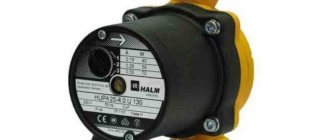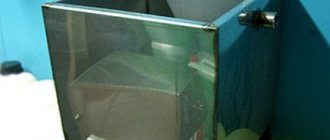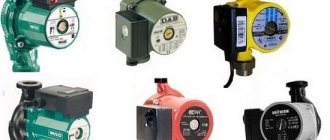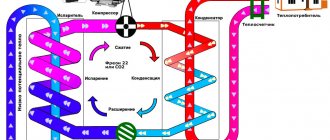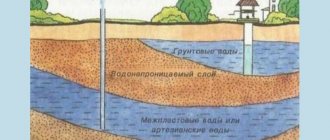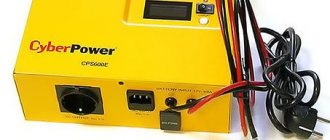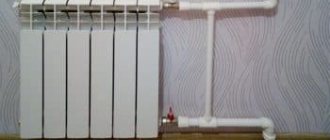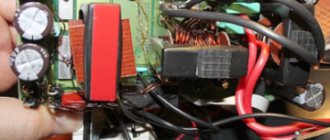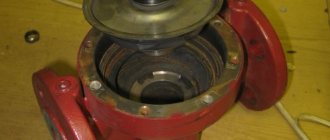The heating system in a private house, as a rule, comes in two types - with natural and forced circulation. If in the first case water moves due to thermal expansion, then during forced circulation the coolant is pushed into the pipeline by the impellers of electric pumps, and for efficient operation, the correct selection of a circulation pump for the heating system is important.
The task of selecting a suitable model includes choosing its operating principle and calculating the main parameters - the volume of pumped coolant and pressure (supply height). You can carry out the necessary calculations yourself using formulas, tables or online calculators - for this you need to know what initial data to enter and how to make the calculations correctly.
Fig. 1 Circulation pumps for a private house in operation
What is a circulation pump for?
Open heating systems, in which the coolant circulates in a circle, operate according to the following scheme: cooled water enters the boiler, and after heating due to thermal expansion, it rises up through the heating pipes, heating the radiators. Then, along a closed circuit, it goes down and through a horizontal pipeline with a slight slope again reaches the heating elements of the boiler.
The main disadvantage of natural circulation is the small size of the circuit, the length of which does not exceed 30 meters, therefore forced circulation is used in most household heating systems.
To move water through pipes into the main, an electric pump is installed, which pushes the coolant with the blades of its impeller. The temperature in heating radiators is adjusted by changing the temperature of the water in the heating boiler; the second method is by regulating the speed of water flow through the pipes.
Many types of circular heaters have 2 or 3 (less often 4) speeds, which make it possible to increase the heating properties of radiators by increasing the speed of coolant movement.
Fig.2 Heating system with forced circulation of coolant
Example as a check
The correctness of calculations using the presented methodology can be verified by comparing their results with the results of accurate calculations in a real project, carried out in accordance with SNiP.
The assignment required calculating a circulation pump for a two-pipe heating system with floor-by-floor piping from the collector. It was previously determined that the building's heat requirement is 45.6 kW, and the coolant flow required for heating is 2.02 cubic meters per hour. The piping diagram to the most distant radiator includes four sections and a heat control valve.
The total pressure losses in them are equal to:
DP = 0.63 + 0.111 + 0.142 + 0.289 = 1.178 m
According to SNiP 2.04.05-91*, 10% should be added to this value for unaccounted pressure losses:
DP = 1.178 x 1.1 = 1.296 m
Thus, the circulator for this system must provide a supply of 2.02 cubic m/h of coolant and a pressure of 1.3 m. The HZ 401 (Deutsche Vortex) or UPS 25-40 (Grundfos) pump meets these conditions.
When calculating using the method outlined in the article, we obtain: H = 0.015 x (3.2 + 4.4 + 8.9 + 21.7) x 1.3 x 1.7 = 1.266 m,
Circular pump device
In the domestic water supply, the leading place is occupied by electric pumps of the centrifugal principle of operation - during intake, the liquid enters the centrifugal wheel through the inlet located in the center of its axis and is pushed out through the side outlet pipe.
In circular machines, the coolant enters the working chamber through the central hole, and then is pushed out by the blades of the centrifugal wheel through the outlet pipe located in the side of its body. Thus, according to the principle of operation, circulation devices can be classified as centrifugal types, having an efficiency coefficient of no more than 80% and sensitive to solid impurities in water.
Structurally, the electric pump consists of a housing, inside which is placed a moisture-protected electric motor with an impeller on the shaft; generally, the wheels of closed-type pumps consist of two disks, between which feed blades are placed.
Rice. 3 Option for installing the pump in a single-pipe circuit with heated floors
Inclusion of recirculation pumps in the gap between the network heater and the boiler.
In peak water heating boiler houses located in close proximity to heat consumers, when using fuel oil as fuel, for an open-loop heat supply circuit, a scheme was used to include recirculation pumps in the cut between the network heater and the boiler, Figure 5:
The recirculation pump supplies water to the boiler with a temperature of at least 110ºС, from where hot water with a temperature of 150ºС or more is supplied to the fuel oil system, to the make-up water heater and to the network heater. Cold water from the fuel oil facility is supplied to the return water pipeline, passes through the network heater and enters the network for heat consumers. Water from the network heater with a tP of at least 110ºC is supplied to the inlet of the recirculation pump. Raw water is preheated to a temperature of 20 ºC before chemical treatment, for example, with a water-water heater and water from the fuel oil plant. After chemical treatment, the make-up water is heated to 50-70 ºС and enters a vacuum deaerator, and from it into storage tanks (not shown in Fig. 5).
Accumulation tanks accumulate water during periods of water withdrawal less than the daily average and release an additional amount of deaerated water into the circulation circuit of the boiler. The heating network is fed from the same circuit through the fuel oil facility. If necessary, the heating network can be recharged with a make-up water pump through a transverse jumper with a valve in front of the network heater (not shown in Fig. 5). Installing battery tanks allows the hot water supply equipment to operate with a constant average daily load, which is the most economical solution.
All boiler room equipment intended for feeding the heating network should be calculated on the average hourly water consumption per day with maximum water withdrawal.
The heat load is regulated by changing the performance of the recirculation pump. For this purpose, a control valve with an automatic drive is installed on the supply pipeline. The valve is controlled taking into account the water temperature in the return pipeline. When the return water temperature decreases, the valve rises and increases the flow area, which leads to a decrease in the resistance of the recirculation circuit, an increase in the performance of the recirculation pump and a decrease in the thermal load on the network heater. At the same time, less fuel and air are supplied to the boiler to reduce its operating power.
The heat load control system is implemented in such a way that with any change in heat consumption tВК remains at least 110ºС.
What types of circulation pumps are there?
The pumps in the heating main are designed to move the coolant; their task is not to increase the pressure (booster pumps are installed for this), it is created only to overcome the hydraulic resistance.
The supply volume depends on the speed of movement of the liquid, and accordingly the speed of rotation of the impeller on the electric motor shaft.
Circular pipes belong to the In-Line type, in which the inlet and outlet pipes are located on the same line, and the nominal passage has the same cross-section along the entire length.
A distinctive feature of circular electric pumps is the dependence of the pressure on the design of the wheel blades on the electric motor shaft and the frequency of its revolutions, while all types are divided into two groups: with a frequency N of more than 1500 rpm. units are classified as high-speed; if the speed is less than 1500 rpm, they are called low-speed. By changing the power, you can regulate the flow Q, which is directly proportional to the rotation speed of the impeller N.
When operating the equipment, it should be taken into account that the change in power consumption P1\P2 is proportional to the square of the change in pressure H1\H2 and the cubic degree of the change in the rotation speed N1\N2 of the engine shaft.
When the rotation speed is doubled, the pressure increases 4 times, and the power consumption increases 8 times; the same proportion is maintained when the speed decreases.
Fig.4 Domestic circulation electric pumps for water supply and heating
It should be taken into account that low-speed types have a more complex design and a high price, which is fully compensated by the savings in electricity consumed by the electric drive when choosing this modification. If a unit is installed with stepless control of the rotation speed of the electric motor shaft depending on the temperature of the conductive body, then the energy savings will be even greater.
The optimal efficiency of electric pumps is obtained when its operating point is located in the middle third of the characteristics; for each brand, the manufacturer indicates the optimal parameter.
When choosing a circulation pump for heating, two main design options are considered - with a dry or wet rotor.
With dry rotor
In samples with a dry rotor, only the impeller on the electric motor shaft is immersed in the coolant flow, rotating on bearings that are separated from the rotor and stator of the motor by sliding mechanical seals. A high degree of sealing is created through the use of two tightly fitted ceramic and high-strength graphite spring-loaded rings, one of which rotates on the shaft and the other is statically fixed in the housing.
When rotating, a thin film of water is formed between the surfaces of the sealing washers, which acts as a lubricant and performs cooling functions. The devices are equipped with air-cooled electric motors; powerful samples have an impeller to supply air to the motor.
The efficiency of units with a dry rotor depends on the power and is 30% - 65% for devices with a power of up to 1500 W, 35% - 75% for modifications with a power of 1500 - 7500 W, and 40 - 80% for power models of 7500 - 45000 W .
Typically, the power indicator required for a household unit rarely exceeds 1500 W, while the maximum efficiency ceiling for equipment with a dry rotor is 65%.
Dry rotor circulation pumps are designed to supply liquid with high pressure; they are more often used in hot water supply (DHW) systems.
Fig. 5 Circular electric pump with a dry rotor for a heating system - structural device
With wet rotor
Models with a wet rotor are used only in closed heating circuits; they ensure rapid movement of liquid through pipes, which makes it possible to reduce the cross-section of the pipeline and reduce the amount of coolant in the system - these factors help reduce the overall costs of the heating system.
A relatively small amount of heat-conducting fluid increases the speed of response to changes in settings and facilitates adjustment.
In the design of the model, the rotor is separated from the stator by a thin-walled glass and rotates in liquid on bearings, which are lubricated and cooled by a coolant. The glass is usually made of non-magnetic stainless steel or carbon fiber, its wall thickness is 0.1 - 0.3 mm, the bearing material is pressed ceramic or sintered graphite alloy.
Electric pumps with a wet rotor do not have seals or cooling fiber - due to this they are characterized by silent operation. Their rotation speed is adjusted in steps manually or using automatic equipment in continuous mode, monitoring changes in pressure difference or temperature; if desired, the automatic system is configured to turn on the unit at a given time.
Modern devices are structurally built according to a modular principle, which facilitates their repair and operation; the models have a screw plug in the body to remove air when setting up the system.
Imported models of electric pumps and their parameters are designed to operate from a single-phase network with an alternating voltage of 230 V or from a three-phase network with a voltage of 400 V.
The efficiency of units with a wet rotor is lower than that of dry models due to the larger distance between the stator and the rotor, and as in all types, it increases with increasing power and overall dimensions of the unit. For modifications with a power of up to 100 watts, the efficiency is 5% - 25%, from 100 to 500 watts. - 20% - 40%, from 500 to 2500 W. - 30% - 40%.
It should be noted that at the highest power of an electric pump for a private home, about 1000 W, the efficiency of types with a dry and wet rotor differs by less than one and a half times.
This factor does not have a strong influence on the selection of a pump for the heating system due to the significant advantages of models with a wet rotor (silence, high throughput, small pipeline cross-section) over dry rotor units.
Fig.6 Glandless rotor pumps - design
Control method
It is quite acceptable to constantly maintain the circulation of hot water in the pipes, but this is uneconomical and unjustified. Hot water is not used constantly. At night, while all the residents are sleeping, it is useless to keep the water in the pipes hot, the same applies to the time when everyone is at work or school.
If the pipes are laid out correctly, then thermal insulation is required, so that once hot water gets into the pipes, it does not cool down instantly. Therefore, there is no need to constantly pump water from the boiler into the pipes and back; periodic operation of the pump is sufficient, which reduces the load on it and the hot water system as a whole. There is no need to talk about saving electricity, since the consumption of the recirculation pump is low.
Two main control methods are used:
- according to temperature sensor readings;
- according to a timer (schedule).
Both options are in demand, although they differ significantly in their operating principles.
By temperature sensor
Grundfos UP 15-14 BT 80
In this case, the pump control unit relies on the readings of a temperature sensor immersed in water inside the circuit pipes. The pump resumes operation as soon as the water has cooled to a certain threshold temperature. This approach significantly reduces the load on the equipment and constantly keeps the water in the pipes heated. In addition, the safety of the hot water supply increases. Having set a sufficiently high response threshold, water is pumped more often through the boiler, where it is additionally heated and disinfected.
By timer
Grundfos UP 15-14 BU
The control unit alternately turns the pump on and off based on the time delays set in the settings. Knowing exactly the parameters of the hot water system, the length of the pipes and their internal volume, thermal insulation and average heat loss, you can select the optimal time during which the water will not have time to cool down. The pump is turned on by a timer signal and pumps all the water. In this case, the duration of operation is also calculated based on the volume of pipes and pump performance.
Another advantage of the timer is the ability to schedule the operation of the recirculation pump for a day or even a week. It is in this case that downtime when hot water is not used is taken into account.
Technical specifications
When deciding how to choose a circulation pump for a heating system, consider its physical and technical characteristics, the main of which are:
- Bandwidth. Measured in cubic meters per hour or liters per minute, it shows the volume of liquid that the electric pump pumps per unit time; the higher the flow rate, the greater the flow rate. The indicator depends on the diameter of the pipeline used and can reach values of up to 15 cubic meters per hour.
- Pressure The value is measured in meters of water column and indicates the height to which the electric pump can push liquid through a vertically installed pipeline. The maximum pressure of a circulating electric pump for varieties with a wet rotor is about 17 meters, although units with higher pressure characteristics may be found, but they are ineffective in operation (they have large overall dimensions and are too expensive).
- Temperature Range. It is clear that in a heating system, pumping equipment must withstand the maximum heating temperature of the coolant with a margin; commonly used modifications are designed for a maximum temperature of up to 110º C; some types can work with liquids with temperatures up to +130º C.
- Noise level. Basically, for use in individual homes, devices with a low noise level are chosen; such features have pumping equipment with a wet rotor, the noise characteristics of which do not exceed 35 - 40 dB.
- Compound. In residential individual houses, a heating main with a small cross-section of up to 1.5 inches is used - in this case, all pumping equipment is installed in the main using threaded connections (designed for pipelines with a diameter of up to 2 inches). The outlet fittings of most household electric pumps are equipped with external threads and are easily integrated into the line using American couplings.
- Dimensional parameters. The installation length is the main indicator of the device when built into a pipeline (for circular types, standard sizes are 130 and 180 mm), the diameter of the inlet and outlet pipes is also taken into account (standard 1 and 1.25 inches).
- Protection class. According to the international classification, the standard protection class for pumping equipment of heating systems is IP44 - this means that the unit is protected from the entry of solid mechanical particles with a diameter of more than 1 millimeter (the first digit in the marking) into the housing, and its electrical part is completely closed from drops and splashes, flying at any angle.
Rules and nuances of equipment operation
A circulation pump is not bought for a year or even two. Therefore, every owner of a country house must ensure that the equipment is in good working order for many years. Reliability and correct operation of the device can only be achieved through correct and timely maintenance.
The list of basic rules for operating a heating pump must include the following aspects:
- it is prohibited to turn on the device with zero supply;
- make sure that the equipment is grounded;
- make sure that the electric motor does not heat up above the permissible norm;
- check the connection in the terminal box for the presence/absence of damage, and all cables must be completely dry;
- make sure that there is no extraneous noise or vibration when the device starts;
- the equipment must operate at the coolant flow level recommended by the manufacturer;
- It is forbidden to run the circulation pump without water.
If the equipment is idle for a long time, it is recommended to turn it on for 10-30 minutes every month. This simple rule will help avoid oxidation and, as a result, shaft blocking.
If any malfunctions or problems occur in the operation of the pump, you should call a specialist as soon as possible. This will help get rid of many problems and unplanned financial expenses.
Particular attention must be paid to the temperature of the coolant. It should not exceed 60-65 degrees Celsius. If you neglect this rule, sediment will appear in the pipes and inside the pump, which will negatively affect the operation of the entire heating system.
Marking
Pumping equipment from different manufacturers has its own markings, most often the pressure (nominal or maximum value), flow volume (in cubic meters per hour or liters per minute, also nominal or maximum values) and the nominal diameter of the passage channel in millimeters are indicated on the body.
In Grundfos models, the body material, type of connection and installation length are indicated; in the Wilo model range, the main indicators are the internal diameter of the nominal diameter and the maximum pressure.
Selection of a circulation pump for a heating system - criteria
When choosing a circulation pump for the heating system of a private home, they almost always give preference to models with a wet rotor, specially designed for operation in any household lines of varying lengths and supply volumes.
These devices have the following advantages compared to other types:
- low noise level,
- small overall dimensions,
- manual and automatic adjustment of the number of shaft revolutions per minute,
- pressure and volume indicators,
- suitable for all heating systems of individual houses.
Selection of a circulation pump for a heating system by the number of speeds
To increase operating efficiency and save energy resources, it is better to take models with stepwise (from 2 to 4 speeds) or automatic control of the electric motor speed.
If automation is used to control the frequency, then energy savings compared to standard models reach 50%, which is about 8% of the electricity consumption of the entire house.
Rice. 8 The difference between a fake (right) and an original (left)
What else to pay attention to
When purchasing popular Grundfos and Wilo models, there is a high probability of counterfeiting, so you should know some of the differences between the originals and their Chinese counterparts. For example, German Wilo can be distinguished from a Chinese counterfeit by the following characteristics:
- The original sample is slightly larger in size and has a serial number stamped on its top cover.
- A raised arrow in the direction of fluid movement in the original was placed on the inlet pipe.
- The de-airing valve on the fake is yellow in brass color (the same color in the Grundfos analogues)
- The Chinese analogue has a bright shiny sticker on the reverse side indicating energy saving classes.
When purchasing Grundfos electric pumps, the original package must include two union nuts with gaskets, the passport itself is made in black and white colors - the Chinese counterfeit passport is colored and there are no fastening fittings.
Rice. 9 Criteria for selecting a circulation pump for heating
Additional Features and Features
To choose a suitable circulation pump for heating, you still need to think through some details.
It is worth paying attention to the following characteristics:
- Frame. It may be made of cast iron or plastic. Cast iron models are heavier and more expensive. Plastic ones have a lower price. The service life is almost the same.
- Working pressure in the system. For private houses, this parameter is not so critical, since the operating pressure is rarely higher than 4 Atm, but for high-rise buildings it is necessary to look at it.
- Temperature of the pumped liquid. If the boiler is solid fuel, it is desirable that this parameter be at least +110°C. For other electronically controlled heating boilers it may be lower, since there you set the operating mode yourself.
- Demanding on the quality of the coolant. For example, the same Grundfos circulation pumps work for a long time without problems with clean coolant, and quickly break down in the presence of abrasive particles and other contaminants. So you shouldn’t put them in a centralized heating system.
- The presence of several speeds of rotation of the impeller. Useful function for different operating modes. The speed is switched manually using a switch located on the body. The leaders - Grundfos and Willo - have models with electronic speed control. They allow you to smoothly change the speed, adjusting the work to the system and weather conditions.
In heating systems that must operate on both natural and forced circulation, a bypass is installed to install the circulation pump
- Connection diameter. It must match the cross-section of the pipe at the installation location. There are, of course, adapters, but you shouldn’t install additional elements unless absolutely necessary.
- Noise level. Although almost all circulation pumps are not particularly noisy, the lower the noise level, the better. Especially if you plan to install it in residential premises.
- Length of electrical cable for connecting to the network. A completely unobvious parameter, but a cord that is too short can become a problem.
- Installation method. Maybe vertical, maybe horizontal, maybe universal.
These are, perhaps, all the parameters that have to be taken into account. But the eternal problem of choosing a manufacturer is what you will have to face.
Selection of a circulation pump for a heating system - calculation based on pump parameters
When determining the parameters of circulation pumps for heating systems, their following main indicators are taken into account:
- Pressure When a heat-conducting liquid moves along the line, it overcomes the hydraulic resistance of pipes, heating radiators, and plumbing fixtures. The pressure created by the pump allows the coolant to move through the pipes, overcoming this resistance; the parameter is measured in meters of water column and shows to what vertical height the working fluid can be raised.
- Feed volume. This indicator indicates the amount of coolant that is supplied to heating radiators per unit of time; the parameter is directly related to the speed of rotation of the impeller.
All other characteristics of pumping equipment (power, motor shaft speed) are derived from the basic parameters. The power and frequency are selected according to the best indicators from the model range of units from different manufacturers after calculating the required pressure and supply volume.
If you do not seek help from specialists, then the parameters of electric pumps are calculated manually, using tables, using online calculators that are available on the websites of some well-known manufacturers, or using computer programs - the latter method is the most accurate.
It is not too difficult to calculate the main technical parameters yourself manually using formulas; the result can be compared with the data indicated in the table, which is provided by some manufacturers. The table (Fig. 11) indicates the power of the heating boiler and the volume of the heated room; a suitable pump model is selected based on these data. The tabulated results are not very accurate - they do not take into account the hydraulic resistance corresponding to losses in the forward and return lines, but they can be used to check the results obtained manually or using online calculators.
Rice. 10 Calculation of the heating power of the house
Why do you need to do the calculation?
The answer to this question is obvious; for the optimal selection of pumping equipment, a preliminary calculation of the circulation pump for the heating system is necessary; the more accurate the calculations, the more optimal the choice will be. A properly selected heating pump will operate within the operating area that provides the highest efficiency - this will save energy resources.
Also, many circular machines have several speeds for adjusting the rotation speed - if the calculations are correct, choose a model with the optimal speed so that switching to other speeds allows you to comfortably use heating or save energy resources without worsening living conditions.
Calculation of pump performance
The supply volume of the electric pump is calculated using several formulas, one of which is:
Q = P/(1.163 x (Tf – Tr)) or Q = 0.86R/(TF–TR) (m3/h)
Where:
- Q is the volume of pumped coolant in cubic meters per hour;
- P – thermal consumption of heated premises (thermal power) in W;
- (Tf - Tr) - the temperature difference in the pipes leaving the boiler and supplying water back (for long pipelines with water heated floors, the difference is about 20 C; if short circuits with a small number of heating radiators are used, the value is taken about 10 C; if only a small area underfloor heating is heated, the temperature difference is taken equal to 5 C.);
- 1.163 – coefficient of specific heat capacity of water in W.*h./kg.*K. (for antifreeze, the indicator has a different meaning, determined from reference literature).
Another formula that allows you to select a circulation pump for a heating system is as follows:
Q = 3.6 x P/(C x (Tf - Tr)), (m.cub./h.)
where: C is the heat capacity (for water it is 4.2 kJ/kg*C), the remaining symbols are similar to those given in the previous formula.
When calculating the thermal power of a room that is being heated, we are guided by SNiP 2.04.07-86 for heating networks; in them, for one- or two-story buildings at an external temperature of -20 to -30º C, a heat consumption indicator of 173 - 177 Watts per square meter is accepted, for For larger buildings with three or four floors, this parameter is 97 - 101 W/sq.m.
It is clear that the total thermal power of energy consumed by the entire house, which is necessary for calculations, consists of summing up the areas of all rooms in which heating radiators are installed.
The above formulas are used in the initial calculations of the heating main - on their basis, depending on the heat consumption of the premises, a heating boiler is selected. If it is installed, instead of the required thermal power, the boiler parameters are used in the formula, example (boiler power 50 kW.):
How to calculate hydraulic losses of a heating system
The choice of a circulation pump based on its power and the pressure it creates, as mentioned above, is also influenced by such an important parameter of the heating system as the hydraulic resistance, which is created by all elements of its equipment. Knowing the hydraulic resistance created by individual elements of the heating system, you can calculate the suction height of the pump and, guided by this parameter, select the equipment model according to the power and pressure created. To calculate the suction height of the pump, which is designated by the letter H, the following formula is needed:
H = 1.3x(R1L1+R2L2+Z1……..Zn)/10000.
The parameters used in this formula are shown in the table.
Table 3. Parameters for calculating suction lift
The values of R1 and R2 used in this formula should be selected using a special information table.
The values of hydraulic resistance created by various devices that are used to equip heating systems are usually indicated in the technical documentation for them. If there is no such data in the device passport, then you can use the approximate values of hydraulic resistance:
- heating boiler – 1000–2000 Pa;
- sanitary mixer – 2000–4000 Pa;
- thermal valve – 5000–10000 Pa;
- device for determining the amount of heat - 1000–1500 Pa.
There are special information tables from which you can determine the hydraulic resistance for almost any element of heating system equipment.
Knowing the suction height, which is calculated using the above formula, you can optimally select pumping equipment based on its power, and also determine what the pump pressure should be.
Number of pump speeds
Well-known manufacturers of pumping equipment for heating equip their units with shaft rotation speed switches; in some models, the speed of the device is automatically adjusted. During operation, this creates additional convenience: since heating the liquid takes quite a long time, to quickly warm up the premises, you can set the maximum speed of the electric pump or save energy by setting the minimum speed of the electric motor when the room is heated.
The number of speeds, depending on the manufacturer, can be from 2 to 4 - the more there are, the more effectively you can use the circular in the heating system, and the most economical option is electronic speed control.
Fig. 13 Selection of electric pump according to pressure characteristics
Manufacturers and prices
Heating is the main system of a private home; unlike water supply and sewerage, its stop can cause significant financial damage if it breaks down in winter and defrosts. Even if the owners are present in the house and the circular device is out of order, you will have to urgently buy a new device, and this is not always possible in remote rural areas. Also, high-quality pumping equipment for heating increases living comfort and saves energy resources - so it is better to choose models from well-known manufacturers, avoiding the Chinese counterfeits described above.
Wilo is a well-known German manufacturer that supplies the market with a wide range of household circular saws of the RS, Stratos, Smart, Top series, all modifications have the following features:
- Manufactured in accordance with the European energy saving directive EnEV for heating circuits with a thermal power of more than 25 kW, according to which only automatic control of the operation of pumping equipment and the presence of at least 3 stages of regulation of electricity consumption are allowed.
- Designed for European AC voltage of 230/400 V with a tolerance of 10%.
- The housings are mainly made of cast iron.
- The power of the units, depending on the pressure and volumetric characteristics, ranges from 40 to 200 watts; the previously selected electric pump for a one-inch pipe Wilo - Star RS 25\6 has a power of 99 watts.
- The cost of Wilo circular electric pumps ranges from 50 to 100 USD.
Rice. 14. Selection of a circulation pump for a heating system from popular brands Grundfos, Wilo, DAB
Grundfos is a world-famous Danish manufacturer of pumping equipment; the market offers models UP, UPS, UPSD, Solar and their more modern analogues Alpha2, which have the following features:
- The cases are made of cast iron, brass and stainless steel (marked with the letter N).
- UPS models are equipped with 3 shaft rotation speeds; in Alpha2 the frequency is automatically adjusted.
- There is a wide range of powerful models with a supply volume of up to 15 m3/cu.m. and pressure up to 15 m.
- The cost of Grundfos electric pumps is 70 - 100 USD, the price of powerful devices can reach up to 500 USD.
If we compare the power of Wilo and Grundfos units, then the Grundfos UPS 25-60 180, similar to the previously reviewed Star RS 25\6 device from Wilo, consumes one and a half times less electricity - its power is 60 W. In addition, Grundfos has a maximum supply volume of 4.35 m3/h. versus 3.5 m.cub./h. at Wilo.
DAB is a well-known Italian manufacturer that supplies the market with household circular pumps of the A and VA series, their distinctive features:
- Single-phase models have 3 rotation speeds and built-in overload protection.
- The operating temperature of the coolant is from -10 to +110 C.
- For domestic use, the VA line is most suitable, the maximum productivity of which is 3.5 cubic meters per hour and the maximum pressure is 6.5 m (for the A series, the corresponding maximum values are 16 cubic meters per hour and 11 m.) .
The choice of DAB models is the best option in terms of price and quality ratio, the DAB VA 35/180 circular machine with a maximum productivity of 3 m3/h. and a head of 4.3 m costs about 60 USD. - this is for 40 USD cheaper than Grundfos and Wilo.
Rice. 15 DAB options
How to choose a hot water recirculation pump?
When purchasing equipment for hot water recirculation, you need to decide on its main parameters. These include:
- Productivity - this characteristic depends on the area of housing. On average, for a two-story private house or a three-room apartment, a unit that pumps 70–100 liters of coolant per minute is sufficient;
- Pressure is another important characteristic that indicates the maximum height of coolant supply. In the case of a two-story private house, you should choose a device that creates a pressure of 3–4 m;
- Energy consumption - this factor allows you to determine how much it will cost to operate a recirculation pump. It must be remembered that the more powerful and productive the unit, the more expensive its use will be;
- Availability of built-in protection - it is best to buy a pump equipped with a water flow relay. This element will protect the pump from running dry and, as a result, overheating of the unit’s motor.
Other important factors include the pump cooling system. If the unit is not equipped with ventilation, then its motor will constantly heat up and fail.
Recommendations for installing pumps
When installing pumps in the heating main, the following rules must be observed:
- The unit is installed in such a way that its shaft is in a horizontal position; the direction of movement of the coolant must correspond to the arrow on the device body.
- The selected device is fastened with an adjustable plumbing wrench using threaded fasteners (socket nuts from American fittings) with gaskets.
- Connection to the power supply system is made according to the electrical connection diagram, using three wires with a cross-section of at least 0.75 mm. sq. and an outer diameter designed for the sealing coupling in the box.
Before turning on for the first time, check the pipeline for the absence of foreign objects, the tightness of threaded connections, the correct connection of wires and the parameters of the power supply network, and make sure that the shut-off valves are open.
When turned on, remove air from the pump by unscrewing the screw plug, check the current strength in the electric motor winding with an ammeter (it must correspond to the data given on the housing marking), and make sure that there is no increased vibration and noise during operation of the unit.
Rice. 16 Connection and installation of a Grundfos circular distributor with a bypass branch
Performance calculation
One of the control parameters is the performance of pumping equipment, which is calculated from the ratio:
– the amount of thermal energy consumed in a specific room;
– the performance value of the pumping device;
– specific heat capacity, if water is used as the coolant; for other types (transformer oil, antifreeze, etc.) the corresponding data are used;
– the temperature difference between the forward and return branches of the heating system, which can be:
- 20 o C – with a normal heating system for residential areas;
- 10 o C – temperature level in non-residential areas with low-temperature heating;
- 5 o C – temperature of the coolant in the heated floor system.
The performance indicator is a passport characteristic; in technical documentation it is reflected as cubic meters per hour. In order for the calculation result to correspond to the form we are familiar with, it must be divided by the specific gravity of water.
Let's give an example of a calculation: the area of the heated room is 200 square meters, therefore, to heat it, an energy expenditure of 20,000 W will be required. The room is equipped with a normal heating system with a temperature difference of 20 o C. Using these numerical values in the above formula, we obtain:
20000/(1.16 x 20) = 862 kg/hour,
recalculation into usual values gives the result
862 / 971.8 = 0.887 m 3 / hour.
To heat the specified room, you will need a pump with a capacity of at least 0.9 m 3 / hour. This indicator must be looked for in your passport.
To calculate this characteristic, you can use the following formula:
G = 3.6Q/(cx dT) kg/hour, where
c is the specific heat capacity of the medium used in heating.
The easiest way to choose a pump is if the boiler power is already known. In this case, you can apply the relation:
Q – unit productivity;
N – boiler power;
dT – temperature difference at the boiler outlet and return.
The photo above shows the correct connection of the unit for a heating system using a bypass. This placement allows the liquid to flow in a roundabout way if it is necessary to carry out repair work or replace the pump without stopping the functioning of the heating system. See how to make heating in an honest house yourself.
Important! The rotor is only positioned horizontally! The direction of flow is indicated by an arrow on the housing.
Installation features
As a rule, circular electric pumps are installed in the main using a bypass - a parallel pipeline with a ball valve through which coolant is supplied when the pump branch is turned off. This design allows you to remove the circular valve for adjustment, repair or replacement without draining the coolant from the system.
Choosing the right circulation pump for heating is a responsible task, the solution of which is best left to specialists. The comfort and efficiency of the heating system (optimal efficiency of the device), as well as energy consumption, the savings of which, with the right solution, can reach 80%, depend on the selected unit.
If you wish, you can independently select a circulation pump for the heating system, make calculations using formulas; the highest accuracy of calculations is obtained when using computer programs. When working with programs, you need to understand how to enter data correctly - in many cases this requires special technical knowledge, which will take some time to obtain
Common breakdowns
The most common problem that causes equipment that provides forced pumping of coolant to fail is its prolonged downtime.
Most often, the heating system is actively used in winter, and is turned off during the warm season. But since the water in it is not clean, sediment forms in the pipes over time. Due to the accumulation of hardness salts between the impeller and the pump, the unit stops working and may fail.
The above problem can be solved quite easily. To do this, you need to try to start the equipment yourself by unscrewing the nut and manually turning the pump shaft. Often this action is more than enough.
If the device still does not start, then the only solution is to dismantle the rotor and then thoroughly clean the pump of accumulated salt deposits.
